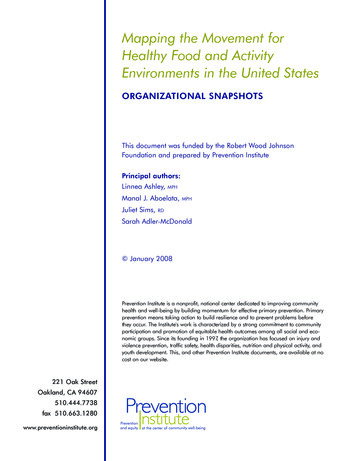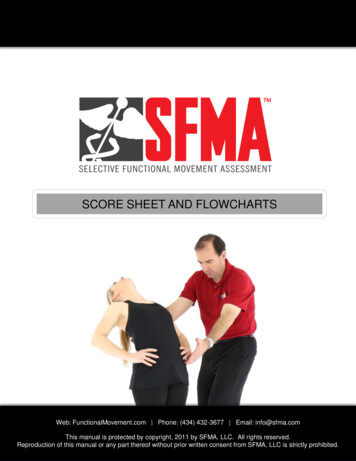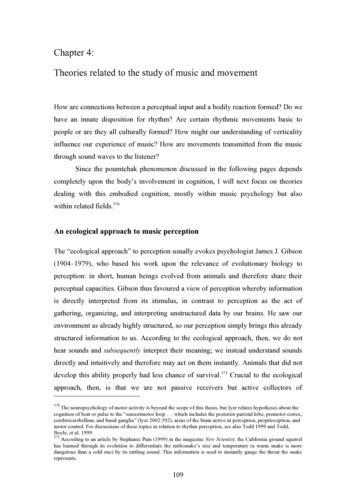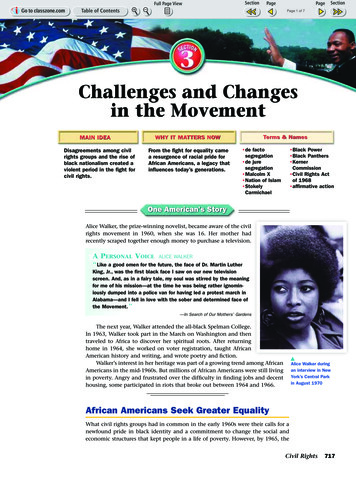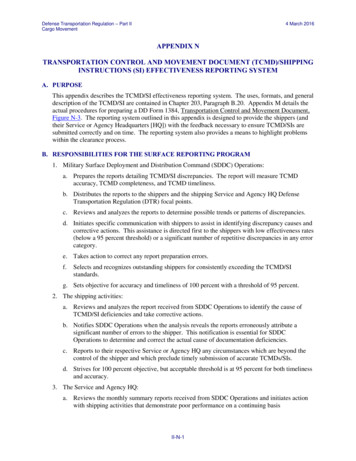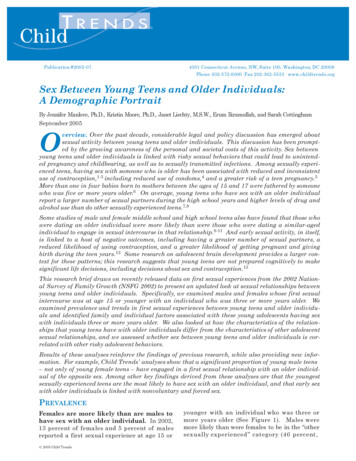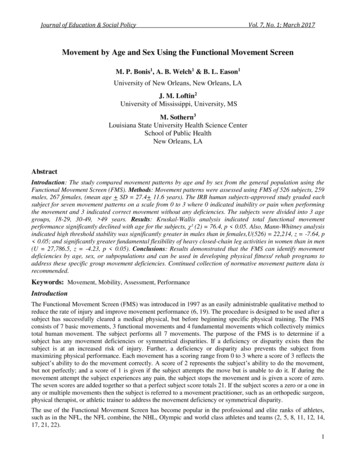
Transcription
Journal of Education & Social PolicyVol. 7, No. 1; March 2017Movement by Age and Sex Using the Functional Movement ScreenM. P. Bonis1, A. B. Welch1 & B. L. Eason1University of New Orleans, New Orleans, LAJ. M. Loftin2University of Mississippi, University, MSM. Sothern3Louisiana State University Health Science CenterSchool of Public HealthNew Orleans, LAAbstractIntroduction: The study compared movement patterns by age and by sex from the general population using theFunctional Movement Screen (FMS). Methods: Movement patterns were assessed using FMS of 526 subjects, 259males, 267 females, (mean age SD 27.4 11.6 years). The IRB human subjects-approved study graded eachsubject for seven movement patterns on a scale from 0 to 3 where 0 indicated inability or pain when performingthe movement and 3 indicated correct movement without any deficiencies. The subjects were divided into 3 agegroups, 18-29, 30-49, 49 years. Results: Kruskal-Wallis analysis indicated total functional movementperformance significantly declined with age for the subjects, χ² (2) 76.4, p 0.05. Also, Mann-Whitney analysisindicated high threshold stability was significantly greater in males than in females,U(526) 22,214, z -7.64, p 0.05; and significantly greater fundamental flexibility of heavy closed-chain leg activities in women than in men(U 27,786.5, z -4.23, p 0.05). Conclusions: Results demonstrated that the FMS can identify movementdeficiencies by age, sex, or subpopulations and can be used in developing physical fitness/ rehab programs toaddress these specific group movement deficiencies. Continued collection of normative movement pattern data isrecommended.Keywords: Movement, Mobility, Assessment, PerformanceIntroductionThe Functional Movement Screen (FMS) was introduced in 1997 as an easily administrable qualitative method toreduce the rate of injury and improve movement performance (6, 19). The procedure is designed to be used after asubject has successfully cleared a medical physical, but before beginning specific physical training. The FMSconsists of 7 basic movements, 3 functional movements and 4 fundamental movements which collectively mimicstotal human movement. The subject performs all 7 movements. The purpose of the FMS is to determine if asubject has any movement deficiencies or symmetrical disparities. If a deficiency or disparity exists then thesubject is at an increased risk of injury. Further, a deficiency or disparity also prevents the subject frommaximizing physical performance. Each movement has a scoring range from 0 to 3 where a score of 3 reflects thesubject’s ability to do the movement correctly. A score of 2 represents the subject’s ability to do the movement,but not perfectly; and a score of 1 is given if the subject attempts the move but is unable to do it. If during themovement attempt the subject experiences any pain, the subject stops the movement and is given a score of zero.The seven scores are added together so that a perfect subject score totals 21. If the subject scores a zero or a one inany or multiple movements then the subject is referred to a movement practitioner, such as an orthopedic surgeon,physical therapist, or athletic trainer to address the movement deficiency or symmetrical disparity.The use of the Functional Movement Screen has become popular in the professional and elite ranks of athletes,such as in the NFL, the NFL combine, the NHL, Olympic and world class athletes and teams (2, 5, 8, 11, 12, 14,17, 21, 22).1
ISSN 2375-0782 (Print) 2375-0790 (Online) Center for Promoting Ideas, USAwww.jespnet.comThe military and first-responder organizations have also begun using the FMS on its new recruits to minimize thequantity and the degree of training injuries during “boot camp” (4,7,13,15,20). While there has been literatureregarding the use of FMS on the general population in Canada (1), to date there is no current study using FMS toexamine normative data in the general population of the U.S. The objective of this study is to examine FMSscores of adults within the U.S. by age and by sex.MethodsThe study consisted of a convenience sample of 526 subjects, 267 females and 259 males, ranging in age from 18years old to 73 years old (mean age S.D 27.4 11.6 years) (See Table 1).The subjects were informed of thetype of research being conducted. They provided written informed consent and agreed to perform the screens andto answer some basic physical data such as age, height, weight, hand dominance, and sex so that the cumulativeresults could be used in the study. The project was Institutional Review Board (IRB)-approved from theUniversity of New Orleans.The study was a Motor Learning project and the testers conducting the FMS were senior level undergraduatestudents in the Human Performance and Health Promotion Program at the University of New Orleans. Theprimary investigator (P.I.) of the project has a Level One FMS Certification. The participating student testers wereHuman Subjects certified and had at least five hours of FMS training which included inter-tester and intra-testerreliability training by the P.I. before beginning data collection (10, 18). Previous research indicated that FMSqualitative procedures were conducive to yielding reliable inter-tester and intra-tester data (9, 16).DesignAfter receiving written informed consent the subjects were given a questionnaire to provide their age, date ofbirth, hand dominance, and sex. Their height was measured using a stadiometer and their weight was measuredusing a Tanita portable digital scale that was calibrated prior to measurements. The subjects were giveninstructions on how to perform the seven movements (See Figure 1) which consisted of the following:(Fig 1.1 Squatting) - The Deep Squat is a functional movement pattern representing loading patterns on both legs.(Fig 1.2 Stepping) - The Hurdle Step is a functional movement pattern representing loading patterns on a singleleg stance.(Fig 1.3 Lunging) -The In-Line Lunge is a functional movement pattern representing loading patterns in the lungeposition.(Fig 1.4 Reaching) -The Shoulder Mobility Movement represents fundamental mobility of both heavy overheadpushing and heavy arm pushing.(Fig 1.5 Leg Rising) - The Active Straight Leg Raise represents fundamental mobility of heavy closed-chainloaded activities in running and polymeric activities.(Fig 1.6 Push-up) - The Trunk Stability Push-up is a high threshold stabilization pattern representing heavy upperand lower body loads and vigorous plyometric activities; and(Fig 1.7 Rotary Stability) - The Rotary Stability Movement is a sub-maximal stabilization pattern representingconventional core training resulting in high threshold core control.The subjects could have up to 3 attempts to complete each movement where the scores ranged from zero to three.A score of three was given if done correctly. A score of two was given if done, but not totally correct. A score ofone was given if the movement was attempted but the subjects were unable to do the movement or maintain theirbalance. Finally, if at any time during an attempt the subjects experienced any pain they were advised toimmediately stop the attempt and a score of zero was given. For five of the screens except for the Deep Squat andthe Trunk Stability Pushup, the movements were conducted on both the left and right extremities. The final scorefor these movements if different would be the lesser of the 2 scores. After completing the seven movements thefinal score for each movement was cumulatively summed for a total score, with a perfect score being a 21.Thesubjects were also advised that they could stop participation in the study at any time if they no longer wanted toparticipate.StatisticsThe IBM SPSS Version 23 program was used for statistical analysis. The subjects were divided into three agegroups for comparative analysis.2
Journal of Education & Social PolicyVol. 7, No. 1; March 2017The first group consisted of subjects from 18 - 29 years old (n 406). The second group consisted of subjectsfrom 30 - 49 years old (n 68); and the third group consisted of subjects older than 49 years (n 52).Spearmancorrelation, Mann-Whitney, Kruskal-Wallis, and Wilcox non-parametric analyses were conducted on the totaldata set as well as on each age group. (See Table 2)ResultsSpearman correlation analysis was used to determine associations among the variables. Overall, there were weak,negative associations between FMS total scores and the subjects’ age (ρ -0.265, n 526) and BMI (ρ -0.187, n 522). Using non-parametric Mann-Whitney tests there were no significant differences by sex in regard to thetotal FMS score (U 33,320.5, z -0.725, p 0.05); however, there were significant sex differences by specificmovements. Mann-Whitney analysis revealed significantly greater high threshold trunk stability patterns (Pushup) in men compared to women (U 22,214, z -7.64, p 0.05); and significantly greater fundamental flexibilityof heavy closed-chain leg activities (Active Straight leg Raise) in women than in men (U 27,786.5, z -4.23, p 0.05). (See Graphs 2 & 3)Kruskall-Wallace analyses revealed significant decreases in the total FMS score [χ² (2) 76.4, p 0.05] andsignificant decreases in all 7 patterns as the subjects’ age increased. Squat: [χ²(2) 35.8, p 0.05]; Hurdle:[χ²(2) 26.1, p 0.05]; Lunge:[χ²(2) 55.2, p 0.05]; Shoulder Mobility:[χ²(2) 31.9, p 0.05]; Active Straight LegRaise:[χ²(2) 17.3, p 0.05]; Push-up: [χ²(2) 31.7, p 0.05]; and Rotary Stability:[χ²(2) 38.9, p 0.05]. (SeeGraph 3)Wilcox analyses indicated significantly higher scores on the subjects’ dominant side as compared to their nondominant side for some of the specific movements: functional movement patterns(hurdle) z -4.60, p 0.05 and(lunge) z -5.43, p 0.05; fundamental mobility pattern (shoulder mobility) z -5.74, p 0.05; and sub-maximalstabilization pattern (rotary stabilization) z -4.44, p 0.05.Age Group: 18-29 YearsUsing Group 1 data (subjects’ age 18-29 years) Mann-Whitney tests showed no significant differences by sex inregard to the total FMS score (U 19,609, z -0.914, p 0.05); however, there were significant sex differencesby specific movements. Group 1 results revealed significantly greater high threshold trunk stability patterns(Push-up) in men compared to women (U 13,332, z -6.88, p 0.05); and significantly greater fundamentalflexibility of heavy closed-chain leg activities (Active Straight leg Raise) in women than in men (U 17,202, z -3.21, p 0.05).Group 1 Wilcox analyses results indicated significantly higher scores on the subjects’ dominant side as comparedto their non-dominant side for some of the specific movements: functional movement patterns(hurdle) z -4.51, p 0.05 and (lunge) z -5.39, p 0.05; fundamental mobility pattern (shoulder mobility) z -5.60, p 0.05; andsub-maximal stabilization pattern (rotary stabilization) z -4.33, p 0.05.Age Group: 30-49 YearsUsing Group 2 data (subjects’ age 30-49 years) Mann-Whitney tests showed no significant differences by sex inregard to the total FMS score (U 479.5, z -1.21, p 0.05); however, there were significant sex differences byspecific movements. Group 2 results revealed significantly greater high scores in men compared to women inregard to the threshold trunk stability pattern (Push-up: U 297.5, z -3.49, p 0.05), and the functionalmovement pattern (Lunge: U 402.5, z -2.30, p 0.05).Group 2 Wilcox analyses results indicated no significantly different scores between the subjects’ dominant sideand their respective non-dominant side.Age Group: Over 49 YearsUsing Group 3 data (subjects’ age over 49 years) Mann-Whitney tests showed no significant differences by sex inregard to the total FMS score (U 314, z -0.36, p 0.05); however, there were significant sex differences inone specific movement. Group 3 results revealed significantly greater scores in men compared to women inregard to the threshold trunk stability pattern (Push-up: U 210.5, z -2.35, p 0.05). Group 3 Wilcox analysesresults indicated no significantly different scores between the subjects’ dominant side and their respective nondominant side in regard to the hurdle, lunge, shoulder mobility, active straight leg rise, and rotary stabilitymovements.3
ISSN 2375-0782 (Print) 2375-0790 (Online) Center for Promoting Ideas, USAwww.jespnet.comDiscussionStudy results indicated that the overall quality of movement declines significantly with age independent of sex.Males demonstrated significantly better trunk stabilization and plyometric activities than women, while womendisplayed significantly better hip flexibility than men. The 18-29 year old age group indicated symmetricalmovement disparities with the dominant side scores being significantly greater in hurdling, lunging, reaching, androtary stabilization movements.The findings demonstrate that the Functional Movement Screen (FMS) can be utilized to identify functional groupmovement deficiencies by subgroups, age or sex instead of using it only as an individual movement screen. TheFMS can be a powerful resource in promoting public health in the general population. Examination of normativedata can pinpoint general areas of movement deficiencies by occupational, athletic, or recreationalsubpopulations, age, and/or sex. Public health professionals in conjunction with movement practitioners can usethis information to design physical activity programs to specifically focus on improving specific group movementdeficiencies. Over time the risk of movement problems in these targeted groups will be reduced and movementpatterns will be improved with the implementation of these programs.The FMS corrective strategy algorithm is to address mobility, motor control/ stability, and functional deficienciesin that order. Identify scores in the zero and one range and symmetrical disparities
Functional Movement Screen (FMS). Methods: Movement patterns were assessed using FMS of 526 subjects, 259 males, 267 females, (mean age SD 27.4 11.6 years). The IRB human subjects-approved study graded each subject for seven movement patterns on a scale from 0 to 3 where 0 indicated inability or pain when performing the movement and 3 indicated correct movement without


